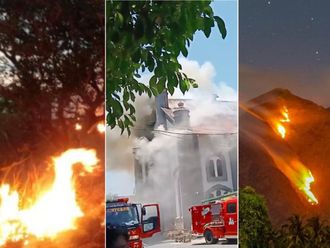Manila: The number of confirmed fatalities from typhoon Jangmi’s onslaught has reached 55, with the Philippine government insisting that it made adequate preparations for the storm’s arrival.
According to Alexander Pama, executive director of the National Disaster Risk Reduction and Management Council (NDRRMC), the number of deaths from Jangmi (named “Senyang” in the Philipppines), stands at 55 killed and 41 people injured, with eight missing.
“At least 113,220 families or 525,618 people had been affected in Mimaropa, Western, Central and Eastern Visayas, the Zamboanga Peninsula, Davao Region and Caraga,” Pama said on Saturday in a report.
Jangmi arrived in the Philippines on December 28 as a low pressure area and developed into a storm on December 29, making initial landfall in Hinantuan, Surigao del Sur.
It carried winds of 55km/h and also made landfall in Anda in Bohol, Sibonga in Cebu, and Guihulngan and Libertad in Negros Oriental.
The latest weather disturbance to hit the Philippines caused flooding and landslides and rendered several roads impassable. It also destroyed a major bridge in Cebu.
As of Saturday, at least 25 roads and 19 bridges were closed to traffic because of floods and damaged bridges.
Compared to the more powerful 200km/h typhoon Hagupit (Ruby), which struck earlier in December, Jangmi claimed more casualties and caused more damage, leaving the people to question who was at fault.
People affected by the storm blamed government for falling short in providing warnings on the amount of rains that Jangmi would bring.
However, Deputy Presidential Spokesperson Abigail Valte, in a Saturday interview aired over government radio station dzRB, said the NDRRMC and its local and regional arms had provided adequate warning to the people.
Baltazar Tribunalo, head of Cebu’s Provincial Disaster Risk Reduction Management Office (PDRRM) had admitted in an interview with Bombo Radyo that among the reasons why there were a number of casualties was that local government agencies tasked to make preparations for the typhoon were on Christmas vacation and that few areas had been ordered evacuated.
But Valte said such reason was not valid.
She said local officials could always refer to the NDRRMC and its website as well as warnings sent through fax, email and text messaging.
Valte said that the government continued to invest in warning systems to avoid casualties whenever disaster strikes.
The government not only focuses on the weather bureau, Pagasa, Valte said, but administration is also improving the capability of responders and rescuers to effectively respond to disasters.
“We continue to invest in the capacity for them to be able to do more,” she said.
The government had claimed victory in the aftermath of typhoon Hagupit, which hit during the first week of December, saying early evacuations had prevented the affected areas from suffering huge casualties.
Hagupit had struck the Visayas in almost the same areas where Haiyan, the most powerful typhoon to hit the Philippines in modern times, tore through on December 8, 2013.
Haiyan left some 6,300 people dead and affected at least 10 million residents in eight regions.












